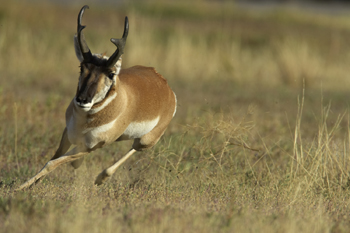The Pronghorn (Antilocapra americana) is endemic to interior western and central North America. Though not an antelope, it is often known colloquially in North America as the Prong Buck, Pronghorn Antelope, or simply Antelope, as it closely resembles true antelopes. It is the only surviving member of the family Antilocapridae. During the Pleistocene period, 12 species existed in North America. About 5 existed when humans entered North America 13,000 years ago; and now all but A. americana are extinct.
Males have a prominent pair of horns on the top of the head, which are made up of an outer sheath of hairlike substance that grows around a bony core; the outer sheath is shed annually. Males have a horn sheath with a prong. Females have smaller horns, sometimes barely visible; they are straight and very rarely pronged. Males are further differentiated from females in that males will have a small patch of black hair at the angle of the mandible. Pronghorns have a distinct, musky odor. Males mark territory with a scent gland located on the sides of the head. They also have very large eyes, with a 320 degree field of vision.
It can run exceptionally fast, being built for maximum predator evasion through running, and is generally accepted to be the fastest land mammal in the New World. The top speed is very hard to measure accurately and varies between individuals; but has been cited as up to 86 km/h. It is often cited as the second-fastest land animal, second only to the cheetah. It can, however, sustain high speeds longer than cheetahs. University of Idaho zoologist John Byers has suggested that the Pronghorn evolved its running ability to escape from extinct predators such as the American cheetah since its speed greatly exceeds that of surviving North American predators.
Pronghorns live primarily in grasslands but also in brushland and deserts. They eat a wide variety of plant foods, often including plants that are unpalatable or toxic to domestic livestock though they also compete with these for food. An ongoing study by the Lava Lake Institute for Science and Conservation and the Wildlife Conservation Society shows an overland migration route that covers more than 160 miles. The migrating pronghorn start travel from the foothills of the Pioneer Mountains through Craters of the Moon National Monument to the Continental Divide. Dr. Scott Bergen of Wildlife Conservation Society says, "This study shows that pronghorn are the true marathoners of the American West. With these new findings, we can confirm that Idaho supports a major overland mammal migration--something that is becoming increasingly rare in the U.S. and worldwide."
By the 1920s, hunting pressure had reduced the Pronghorn population to about 13,000. Protection of habitat and hunting restrictions have allowed their numbers to recover to an estimated population of between 500,000 and 1,000,000. There has been some recent decline in a few localized populations, due to blue tongue disease which is spread from sheep; however the overall trend has been positive since conservation measures were put in place.
Pronghorn migration corridors are threatened by habitat fragmentation and the blocking of traditional migration routes. In a migration study conducted by Lava Lake Institute for Science and Conservation and the Wildlife Conservation Society, at one point the migration corridor bottlenecks to an area only 200 yards wide.
Pronghorns are now quite numerous and outnumbered people in Wyoming and parts of northern Colorado until just recently. It is legally hunted in western states for purposes of population control and food, the meat is rich and lean. There are no major range-wide threats, although localized declines are taking place, particularly to the Sonoran Pronghorn, mainly as a result of, among others, livestock grazing, the construction of roads, fences and other barriers that pose barriers to historical habitat, illegal hunting, insufficient forage and water, and lack of recruitment.
The Pronghorn is Classified as Least Concern (LC) on the IUCN Red List and listed on Appendix I of CITES. Subspecies: Antilocapra americana mexicana, Antilocapra americana peninsularis and Antilocapra americana sonoriensis are listed on Appendix I of CITES. To find out more about conservation efforts, please try US Fish & Wildlife Service or the Wildlife Conservation Society.
Source: Wikipedia, Arkive, CITES.






No comments:
Post a Comment
Many thanks for your contribution. Where applicable, we will respond to you here.